Responsive Boronic Acid-Decorated (Co)polymers: From Glucose Sensors to Autonomous Drug Delivery
Abstract
:1. Introduction
2. Responsiveness of Boronic Acid Containing (Co)polymers
3. Drug Delivery Applications
4. Sensory Applications
5. Conclusions
Acknowledgments
Conflicts of Interest
References
- Hall, D.G. Structure, Properties, and Preparation of Boronic Acid Derivatives. Overview of Their Reactions and Applications. In Boronic Acids: Preparation and Applications in Organic Synthesis and Medicine; Hall, D.G., Ed.; Wiley-VCH Verlag GmbH & Co. KGaA: Weinheim, Germany, 2006. [Google Scholar]
- Vancoillie, G.; Hoogenboom, R. Synthesis and polymerization of boronic acid containing monomers. Polym. Chem. 2016, 7, 5484–5495. [Google Scholar] [CrossRef]
- Miyata, T.; Uragami, T.; Nakamae, K. Biomolecule-sensitive hydrogels. Adv. Drug Deliv. Rev. 2002, 54, 79–98. [Google Scholar] [CrossRef]
- Brooks, W.L.A.; Sumerlin, B.S. Synthesis and Applications of Boronic Acid-Containing Polymers: From Materials to Medicine. Chem. Rev. 2016, 116, 1375–1397. [Google Scholar] [CrossRef] [PubMed]
- Islam, M.R.; Gao, Y.; Li, X.; Zhang, Q.M.; Wei, M.; Serpe, M.J. Stimuli-responsive polymeric materials for human health applications. Chin. Sci. Bull. 2014, 59, 4237–4255. [Google Scholar] [CrossRef]
- Adhikari, B.; Majumdar, S. Polymers in sensor applications. Prog. Polym. Sci. 2004, 29, 699–766. [Google Scholar] [CrossRef]
- Nakahata, M.; Mori, S.; Takashima, Y.; Hashidzume, A.; Yamaguchi, H.; Harada, A. pH- and sugar-responsive gel assemblies based on boronate-catechol interactions. ACS Macro Lett. 2014, 3, 337–340. [Google Scholar] [CrossRef]
- Ye, J.; Chen, Y.; Liu, Z. A boronate affinity sandwich assay: An appealing alternative to immunoassays for the determination of glycoproteins. Angew. Chem. Int. Ed. 2014, 53, 10386–10389. [Google Scholar] [CrossRef] [PubMed]
- Meng, H.; Xiao, P.; Gu, J.; Wen, X.; Xu, J.; Zhao, C.; Zhang, J.; Chen, T. Self-healable macro-/microscopic shape memory hydrogels based on supramolecular interactions. Chem. Commun. 2014, 50, 12277–12280. [Google Scholar] [CrossRef] [PubMed]
- Cash, J.J.; Kubo, T.; Bapat, A.P.; Sumerlin, B.S. Room-temperature self-healing polymers based on dynamic-covalent boronic esters. Macromolecules 2015, 48, 2098–2106. [Google Scholar] [CrossRef]
- Deng, C.C.; Brooks, W.L.A.; Abboud, K.A.; Sumerlin, B.S. Boronic acid-based hydrogels undergo self-healing at neutral and acidic pH. ACS Macro Lett. 2015, 4, 220–224. [Google Scholar] [CrossRef]
- Matsumoto, A.; Kurata, T.; Shiino, D.; Kataoka, K. Swelling and shrinking kinetics of totally synthetic, glucose-responsive polymer gel bearing phenylborate derivative as a glucose-sensing moiety. Macromolecules 2004, 37, 1502–1510. [Google Scholar] [CrossRef]
- Xing, S.; Guan, Y.; Zhang, Y. Kinetics of glucose-induced swelling of P(NIPAM-AAPBA) microgels. Macromolecules 2011, 44, 4479–4486. [Google Scholar] [CrossRef]
- Zhang, M.-J.; Wang, W.; Xie, R.; Ju, X.-J.; Liu, L.; Gu, Y.-Y.; Chu, L.-Y. Microfluidic fabrication of monodisperse microcapsules for glucose-response at physiological temperature. Soft Matter 2013, 9, 4150–4159. [Google Scholar] [CrossRef]
- Matsumoto, A.; Yamamoto, K.; Yoshida, R.; Kataoka, K.; Aoyagi, T.; Miyahara, Y. A totally synthetic glucose responsive gel operating in physiological aqueous conditions. Chem. Commun. 2010, 46, 2203–2205. [Google Scholar] [CrossRef] [PubMed]
- Hasegawa, U.; Nishida, T.; van der Vlies, A.J. Dual stimuli-responsive phenylboronic acid-containing framboidal nanoparticles by one-step aqueous dispersion polymerization. Macromolecules 2015, 48, 4388–4393. [Google Scholar] [CrossRef]
- Cambre, J.N.; Roy, D.; Gondi, S.R.; Sumerlin, B.S. Facile strategy to well-defined water-soluble boronic acid (co)polymers. J. Am. Chem. Soc. 2007, 129, 10348–10349. [Google Scholar] [CrossRef] [PubMed]
- Roy, D.; Cambre, J.N.; Sumerlin, B.S. Sugar-responsive block copolymers by direct RAFT polymerization of unprotected boronic acid monomers. Chem. Commun. 2008, 44, 2477–2479. [Google Scholar] [CrossRef] [PubMed]
- Cambre, J.N.; Roy, D.; Sumerlin, B.S. Tuning the sugar-response of boronic acid block copolymers. J. Polym. Sci. A Polym. Chem. 2012, 50, 3373–3382. [Google Scholar] [CrossRef]
- Maji, S.; Vancoillie, G.; Voorhaar, L.; Zhang, Q.; Hoogenboom, R. RAFT polymerization of 4-vinylphenylboronic acid as the basis for micellar sugar sensors. Macromol. Rapid Commun. 2014, 35, 214–220. [Google Scholar] [CrossRef] [PubMed]
- Roy, D.; Sumerlin, B.S. Glucose-sensitivity of boronic acid block copolymers at physiological pH. ACS Macro Lett. 2012, 1, 529–532. [Google Scholar] [CrossRef]
- Kyoung, T.K.; Cornelissen, J.J.L.M.; Nolte, R.J.M.; Van Hest, J.C.M. Polymeric monosaccharide receptors responsive at neutral pH. J. Am. Chem. Soc. 2009, 131, 13908–13909. [Google Scholar]
- Matsumoto, A.; Yoshida, R.; Kataoka, K. Glucose-responsive polymer gel bearing phenylborate derivative as a glucose-sensing moiety operating at the physiological pH. Biomacromolecules 2004, 5, 1038–1045. [Google Scholar] [CrossRef] [PubMed]
- Uǧuzdoǧan, E.; Kayi, H.; Denkbaş, E.B.; Patir, S.; Tuncel, A. Stimuli-responsive properties of aminophenylboronic acid-carrying thermosensitive copolymers. Polym. Int. 2003, 52, 649–657. [Google Scholar] [CrossRef]
- Elmas, B.; Senel, S.; Tuncel, A. A new thermosensitive fluorescent probe for diol sensing: Poly(N-isopropylacrylamide-co-vinylphenylboronic acid)-alizarin red S complex. React. Funct. Polym. 2007, 67, 87–96. [Google Scholar] [CrossRef]
- Shiomori, K.; Ivanov, A.E.; Galaev, I.Y.; Kawano, Y.; Mattiasson, B. Thermoresponsive properties of sugar sensitive copolymer of N-isopropylacrylamide and 3-(acrylamido)phenylboronic acid. Macromol. Chem. Phys. 2004, 205, 27–34. [Google Scholar] [CrossRef]
- Ivanov, A.E.; Shiomori, K.; Kawano, Y.; Galaev, I.Y.; Mattiasson, B. Effects of polyols, saccharides, and glycoproteins on thermoprecipitation of phenylboronate-containing copolymers. Biomacromolecules 2006, 7, 1017–1024. [Google Scholar] [CrossRef] [PubMed]
- Tuncel, A.; Özdemir, A. Thermally reversible VPBA–NIPAM copolymer gels for nucleotide adsorption. J. Biomater. Sci. Polym. Ed. 2000, 11, 817–831. [Google Scholar] [CrossRef] [PubMed]
- Qing, G.; Wang, X.; Fuchs, H.; Sun, T. Nucleotide-responsive wettability on a smart polymer surface. J. Am. Chem. Soc. 2009, 131, 8370–8371. [Google Scholar] [CrossRef] [PubMed]
- Uğuzdoğan, E.; Denkbaş, E.B.; Tuncel, A. RNA-sensitive N-isopropylacrylamide/vinylphenylboronic acid random copolymer. Macromol. Biosci. 2002, 2, 214–222. [Google Scholar] [CrossRef]
- Zhao, Y.H.; Shantz, D.F. Phenylboronic acid functionalized SBA-15 for sugar capture. Langmuir 2011, 27, 14554–14562. [Google Scholar] [CrossRef] [PubMed]
- Zhang, J.; Ni, Y.; Zheng, X. Preparation of poly(vinylphenylboronic acid) chain grafted poly(glycidylmethacrylate-co-ethylenedimethacrylate) beads for the selective enrichment of glycoprotein. J. Sep. Sci. 2015, 38, 81–86. [Google Scholar] [CrossRef] [PubMed]
- Preinerstorfer, B.; Lämmerhofer, M.; Lindner, W. Synthesis and application of novel phenylboronate affinity materials based on organic polymer particles for selective trapping of glycoproteins. J. Sep. Sci. 2009, 32, 1673–1685. [Google Scholar] [CrossRef] [PubMed]
- Xu, G.; Zhang, W.; Wei, L.; Lu, H.; Yang, P. Boronic acid-functionalized detonation nanodiamond for specific enrichment of glycopeptides in glycoproteome analysis. Analyst 2013, 138, 1876–85. [Google Scholar] [CrossRef] [PubMed]
- Guo, B.; Pan, G.; Guo, Q.; Zhu, C.; Cui, W.; Li, B.; Yang, H. Saccharides and temperature dual-responsive hydrogel layers for harvesting cell sheets. Chem. Commun. 2015, 51, 644–647. [Google Scholar] [CrossRef] [PubMed]
- Talelli, M.; Barz, M.; Rijcken, C.J.F.; Kiessling, F.; Hennink, W.E.; Lammers, T. Core-crosslinked polymeric micelles: Principles, preparation, biomedical applications and clinical translation. Nano Today 2015, 10, 93–117. [Google Scholar] [CrossRef] [PubMed]
- Shiino, D.; Murata, Y.; Kataoka, K.; Koyama, Y.; Yokoyama, M.; Okano, T.; Sakurai, Y. Preparation and characterization of a glucose-responsive insulin-releasing polymer device. Biomaterials 1994, 15, 121–128. [Google Scholar] [CrossRef]
- Shiino, D.; Kataoka, K.; Koyama, Y.; Yokoyama, M.; Okano, T.; Sakurai, Y. A self-regulated insulin delivery system using boronic acid gel. J. Intell. Mater. Syst. Struct. 1994, 5, 311–314. [Google Scholar] [CrossRef]
- Shiino, D.; Murata, Y.; Kubo, A.; Kim, Y.J.; Kataoka, K.; Koyama, Y.; Kikuchi, A.; Yokoyama, M.; Sakurai, Y.; Okano, T. Amine containing phenylboronic acid gel for glucose-responsive insulin release under physiological pH. J. Control. Release 1995, 37, 269–276. [Google Scholar] [CrossRef]
- Shiino, D.; Kubo, A.; Murata, Y.; Koyama, Y.; Kataoka, K.; Kikuchi, A.; Sakurai, Y.; Okano, T. Amine effect on phenylboronic acid complex with glucose under physiological pH in aqueous solution. J. Biomater. Sci. Polym. Ed. 1996, 7, 697–705. [Google Scholar] [CrossRef] [PubMed]
- Kataoka, K.; Miyazaki, H.; Bunya, M.; Okano, T.; Sakurai, Y. Totally synthetic polymer gels responding to external glucose concentration: Their preparation and application to on-off regulation of insulin release. J. Am. Chem. Soc. 1998, 120, 12694–12695. [Google Scholar] [CrossRef]
- Liu, P.; Luo, Q.; Guan, Y.; Zhang, Y. Drug release kinetics from monolayer films of glucose-sensitive microgel. Polymer 2010, 51, 2668–2675. [Google Scholar] [CrossRef]
- Yao, Y.; Wang, X.; Tan, T.; Yang, J. A facile strategy for polymers to achieve glucose-responsive behavior at neutral pH. Soft Matter 2011, 7, 7948–7951. [Google Scholar] [CrossRef]
- Yao, Y.; Zhao, L.; Yang, J.; Yang, J. Glucose-responsive vehicles containing phenylborate ester for controlled insulin release at neutral pH. Biomacromolecules 2012, 13, 1837–1844. [Google Scholar] [CrossRef] [PubMed]
- Yuan, W.; Shen, T.; Wang, J.; Zou, H. Formation–dissociation of glucose, pH and redox triply responsive micelles and controlled release of insulin. Polym. Chem. 2014, 5, 3968–3977. [Google Scholar] [CrossRef]
- Kim, H.; Kang, Y.J.; Kang, S.; Kim, K.T. Monosaccharide-responsive release of insulin from polymersomes of polyboroxole block copolymers at neutral pH. J. Am. Chem. Soc. 2012, 134, 4030–4033. [Google Scholar] [CrossRef] [PubMed]
- Kim, H.; Kang, Y.J.; Jeong, E.S.; Kang, S.; Kim, K.T. Glucose-responsive disassembly of polymersomes of sequence-specific boroxole-containing block copolymers under physiologically relevant conditions. ACS Macro Lett. 2012, 1, 1194–1198. [Google Scholar] [CrossRef]
- Yang, H.; Sun, X.; Liu, G.; Ma, R.; Li, Z.; An, Y.; Shi, L. Glucose-responsive complex micelles for self-regulated release of insulin under physiological conditions. Soft Matter 2013, 9, 8589–8599. [Google Scholar] [CrossRef]
- Yang, H.; Zhang, C.; Li, C.; Liu, Y.; An, Y.; Ma, R.; Shi, L. Glucose-responsive polymer vesicles templated by α-CD/PEG inclusion complex. Biomacromolecules 2015, 16, 1372–1381. [Google Scholar] [CrossRef] [PubMed]
- Kitano, S.; Kataoka, K.; Koyama, Y.; Okano, T.; Sakurai, Y. Glucose-responsive complex formation between poly(viny1 alcohol) and poly(N-vinyl-2-pyrrolidone) with pendent phenylboronic acid moieties. Die Makromol. Chem. Rapid Commun. 1991, 12, 227–233. [Google Scholar] [CrossRef]
- Kitano, S.; Hisamitsu, I.; Koyama, Y.; Kataoka, K.; Okano, T.; Sakurai, Y. Effect of the incorporation of amino groups in a glucose-responsive polymer complex having phenylboronic acid moieties. Polym. Adv. Technol. 1991, 2, 261–264. [Google Scholar] [CrossRef]
- Hisamitsu, I.; Kataoka, K.; Okano, T.; Sakurai, Y. Glucose-responsive gel from phenylborate polymer and poly(vinyl alcohol): Prompt response at physiological ph through the interaction of borate with amino group in the gel. Pharm. Res. 1997, 14, 289–293. [Google Scholar] [CrossRef] [PubMed]
- Ivanov, A.E.; Larsson, H.; Galaev, I.Y.; Mattiasson, B. Synthesis of boronate-containing copolymers of N,N-dimethylacrylamide, their interaction with poly(vinyl alcohol) and rheological behaviour of the gels. Polymer 2004, 45, 2495–2505. [Google Scholar] [CrossRef]
- De Geest, B.G.; Jonas, A.M.; Demeester, J.; De Smedt, S.C. Glucose-responsive polyelectrolyte capsules. Langmuir 2006, 22, 5070–5074. [Google Scholar] [CrossRef] [PubMed]
- Suwa, K.; Nagasaka, M.; Niina, S.; Egawa, Y.; Seki, T.; Anzai, J. Sugar response of layer-by-layer films composed of poly(vinyl alcohol) and poly(amidoamine) dendrimer bearing 4-carboxyphenylboronic acid. Colloid Polym. Sci. 2014, 293, 1043–1048. [Google Scholar] [CrossRef]
- Ivanov, A.E.; Nilsson, L.; Galaev, I.Y.; Mattiasson, B. Boronate-containing polymers form affinity complexes with mucin and enable tight and reversible occlusion of mucosal lumen by poly(vinyl alcohol) gel. Int. J. Pharm. 2008, 358, 36–43. [Google Scholar] [CrossRef] [PubMed]
- Li, R.-Q.; Song, H.-Q.; Xu, F.-J. PGMA-based starlike polycations with flanking phenylboronic acid groups for highly efficient multifunctional gene delivery systems. Polym. Chem. 2015, 6, 6208–6218. [Google Scholar] [CrossRef]
- Chen, F.; Zhang, Z.; Cai, M.; Zhang, X.; Zhong, Z.; Zhuo, R. Phenylboronic-Acid-Modified Amphiphilic Polyether as a Neutral Gene Vector. Macromol. Biosci. 2012, 12, 962–969. [Google Scholar] [CrossRef] [PubMed]
- Peng, Q.; Chen, F.; Zhong, Z.; Zhuo, R. Enhanced gene transfection capability of polyethylenimine by incorporating boronic acid groups. Chem. Commun. 2010, 46, 5888–5890. [Google Scholar] [CrossRef] [PubMed]
- Naito, M.; Ishii, T.; Matsumoto, A.; Miyata, K.; Miyahara, Y.; Kataoka, K. A phenylboronate-functionalized polyion complex micelle for ATP-triggered release of siRNA. Angew. Chem. Int. Ed. 2012, 51, 10751–10755. [Google Scholar] [CrossRef] [PubMed]
- Ren, J.; Zhang, Y.; Zhang, J.; Gao, H.; Liu, G.; Ma, R.; An, Y.; Kong, D.; Shi, L. pH/Sugar Dual Responsive Core-Cross-Linked PIC Micelles for Enhanced Intracellular Protein Delivery. Biomacromolecules 2013, 14, 3434–3443. [Google Scholar] [CrossRef] [PubMed]
- Yang, B.; Lv, Y.; Zhu, J.; Han, Y.; Jia, H.; Chen, W.; Feng, J.; Zhang, X.; Zhuo, R. A pH-responsive drug nanovehicle constructed by reversible attachment of cholesterol to PEGylated poly(l-lysine) via catechol–boronic acid ester formation. Acta Biomater. 2014, 10, 3686–3695. [Google Scholar] [CrossRef] [PubMed]
- Deshayes, S.; Cabral, H.; Ishii, T.; Miura, Y.; Kobayashi, S.; Yamashita, T.; Matsumoto, A.; Miyahara, Y.; Nishiyama, N.; Kataoka, K. Phenylboronic acid-installed polymeric micelles for targeting sialylated epitopes in solid tumors. J. Am. Chem. Soc. 2013, 135, 15501–15507. [Google Scholar] [CrossRef] [PubMed]
- Patterson, S.; Smith, B.D.; Taylor, R.E. Tuning the affinity of a synthetic sialic acid receptor using combinatorial chemistry. Tetrahedron Lett. 1998, 39, 3111–3114. [Google Scholar] [CrossRef]
- Ni, W.; Kaur, G.; Springsteen, G.; Wang, B.; Franzen, S. Regulating the fluorescence intensity of an anthracene boronic acid system: A B-N bond or a hydrolysis mechanism? Bioorg. Chem. 2004, 32, 571–581. [Google Scholar] [CrossRef] [PubMed]
- Arimori, S.; Frimat, K.A.; James, T.D.; Bell, M.L.; Oh, C.S. Modular fluorescence sensors for saccharides. Chem. Commun. 2001, 37, 1836–1837. [Google Scholar] [CrossRef]
- Appleton, B.; Gibson, T.D. Detection of total sugar concentration using photoinduced electron transfer materials: Development of operationally stable, reusable optical sensors. Sens. Actuators B Chem. 2000, 65, 302–304. [Google Scholar] [CrossRef]
- Mader, H.S.; Wolfbeis, O.S. Boronic acid based probes for microdetermination of saccharides and glycosylated biomolecules. Microchim. Acta 2008, 162, 1–34. [Google Scholar] [CrossRef]
- Shibata, H.; Heo, Y.J.; Okitsu, T.; Matsunaga, Y.; Kawanishi, T.; Takeuchi, S. Injectable hydrogel microbeads for fluorescence-based in vivo continuous glucose monitoring. Proc. Natl. Acad. Sci. USA 2010, 107, 17894–17898. [Google Scholar] [CrossRef] [PubMed]
- Heo, Y.J.; Shibata, H.; Okitsu, T.; Kawanishi, T.; Takeuchi, S. Fluorescent hydrogel fibers for long-term in vivo glucose monitoring. In Proceedings of the 2011 16th International Solid-State Sensors, Actuators and Microsystems Conference, Beijing, China, 5–9 June 2011; pp. 2140–2143.
- Springsteen, G.; Wang, B. A detailed examination of boronic acid-diol complexation. Tetrahedron 2002, 58, 5291–5300. [Google Scholar] [CrossRef]
- Dowlut, M.; Hall, D.G. An improved class of sugar-binding boronic acids, soluble and capable of complexing glycosides in neutral water. J. Am. Chem. Soc. 2006, 128, 4226–4227. [Google Scholar] [CrossRef] [PubMed]
- Bérubé, M.; Dowlut, M.; Hall, D.G. Benzoboroxoles as efficient glycopyranoside-binding agents in physiological conditions: Structure and selectivity of complex formation. J. Org. Chem. 2008, 73, 6471–6479. [Google Scholar] [CrossRef] [PubMed]
- Mulla, H.R.; Agard, N.J.; Basu, A. 3-Methoxycarbonyl-5-nitrophenyl boronic acid: High affinity diol recognition at neutral pH. Bioorgan. Med. Chem. Lett. 2004, 14, 25–27. [Google Scholar] [CrossRef]
- Zhang, X.; You, L.; Anslyn, E.V.; Qian, X. Discrimination and classification of ginsenosides and ginsengs using bis-boronic acid receptors in dynamic multicomponent indicator displacement sensor arrays. Chem. Eur. J. 2012, 18, 1102–1110. [Google Scholar] [CrossRef] [PubMed]
- Piest, M.; Zhang, X.; Trinidad, J.; Engbersen, J.F.J. pH-responsive, dynamically restructuring hydrogels formed by reversible crosslinking of PVA with phenylboronic acid functionalised PPO–PEO–PPO spacers (Jeffamines®). Soft Matter 2011, 7, 11111–11118. [Google Scholar] [CrossRef]
- Hajizadeh, S.; Ivanov, A.E.; Jahanshahi, M.; Sanati, M.H.; Zhuravleva, N.V.; Mikhalovska, L.I.; Galaev, I.Y. Glucose sensors with increased sensitivity based on composite gels containing immobilized boronic acid. React. Funct. Polym. 2008, 68, 1625–1634. [Google Scholar] [CrossRef]
- Takahashi, S.; Anzai, J.I. Phenylboronic acid monolayer-modified electrodes sensitive to sugars. Langmuir 2005, 21, 5102–5107. [Google Scholar] [CrossRef] [PubMed]
- Sugnaux, C.; Klok, H.-A. Glucose-Sensitive QCM-Sensors via Direct Surface RAFT Polymerization. Macromol. Rapid Commun. 2014, 35, 1402–1407. [Google Scholar] [CrossRef] [PubMed]
- Minami, T.; Minamiki, T.; Hashima, Y.; Yokoyama, D.; Sekine, T.; Fukuda, K.; Kumaki, D.; Tokito, S. An extended-gate type organic field effect transistor functionalised by phenylboronic acid for saccharide detection in water. Chem. Commun. 2014, 50, 15613–15615. [Google Scholar] [CrossRef] [PubMed]
- Vancoillie, G.; Zhang, Q.; Hoogenboom, R. Chapter 7: Polymeric Temperature Sensors. In Thermometry at the Nanoscale: Techniques and Selected Applications; RSC Publishing: Cambridge, UK, 2015; pp. 190–236. [Google Scholar]
- Reichardt, C. Solvatochromic Dyes as Solvent Polarity Indicators. Chem. Rev. 1994, 94, 2319–2358. [Google Scholar] [CrossRef]
- Inal, S.; Kölsch, J.D.; Chiappisi, L.; Janietz, D.; Gradzielski, M.; Laschewsky, A.; Neher, D. Structure-related differences in the temperature-regulated fluorescence response of LCST type polymers. J. Mater. Chem. C 2013, 1, 6603–6612. [Google Scholar] [CrossRef]
- Pietsch, C.; Hoogenboom, R.; Schubert, U.S. PMMA based soluble polymeric temperature sensors based on UCST transition and solvatochromic dyes. Polym. Chem. 2010, 1, 1005–1008. [Google Scholar] [CrossRef]
- Pietsch, C.; Hoogenboom, R.; Schubert, U.S. Soluble polymeric dual sensor for temperature and pH value. Angew. Chem. Int. Ed. 2009, 48, 5653–5656. [Google Scholar] [CrossRef] [PubMed]
- Vancoillie, G.; Pelz, S.; Holder, E.; Hoogenboom, R. Direct nitroxide mediated (co)polymerization of 4-vinylphenylboronic acid as route towards sugar sensors. Polym. Chem. 2012, 3, 1726–1729. [Google Scholar] [CrossRef]
- Forster, T. Energiewanderung und Fluoreszenz. Naturwissenschaften 1946, 33, 166–175. (In German) [Google Scholar] [CrossRef]
- Wang, D.; Liu, T.; Yin, J.; Liu, S. Stimuli-responsive fluorescent poly(N-isopropylacrylamide) microgels labeled with phenylboronic acid moieties as multifunctional ratiometric probes for glucose and temperatures. Macromolecules 2011, 44, 2282–2290. [Google Scholar] [CrossRef]
- Li, Y.; Xiao, W.; Xiao, K.; Berti, L.; Luo, J.; Tseng, H.P.; Fung, G.; Lam, K.S. Well-defined, reversible boronate crosslinked nanocarriers for targeted drug delivery in response to acidic pH values and cis-diols. Angew. Chem. Int. Ed. 2012, 51, 2864–2869. [Google Scholar] [CrossRef] [PubMed]
- Suri, J.T.; Cordes, D.B.; Cappuccio, F.E.; Wessling, R.A.; Singaram, B. Continuous Glucose Sensing with a Fluorescent Thin-Film Hydrogel. Angew. Chem. Int. Ed. 2003, 42, 5857–5859. [Google Scholar] [CrossRef] [PubMed]
- Vilozny, B.; Schiller, A.; Wessling, R.A.; Singaram, B. Multiwell plates loaded with fluorescent hydrogel sensors for measuring pH and glucose concentration. J. Mater. Chem. 2011, 21, 7589–7595. [Google Scholar] [CrossRef]
- Kanekiyo, Y.; Sato, H.; Tao, H. Saccharide sensing based on saccharide-induced conformational changes in fluorescent boronic acid polymers. Macromol. Rapid Commun. 2005, 26, 1542–1546. [Google Scholar] [CrossRef]
- Yu, C.; Yam, V.W.-W. Glucose sensing via polyanion formation and induced pyrene excimer emission. Chem. Commun. 2009, 45, 1347. [Google Scholar] [CrossRef] [PubMed]
- Asher, S.A.; Alexeev, V.L.; Goponenko, A.V.; Sharma, A.C.; Lednev, I.K.; Wilcox, C.S.; Finegold, D.N. Photonic crystal carbohydrate sensors: Low ionic strength sugar sensing. J. Am. Chem. Soc. 2003, 125, 3322–3329. [Google Scholar] [CrossRef] [PubMed]
- Alexeev, V.L.; Sharma, A.C.; Goponenko, A.V.; Das, S.; Lednev, I.K.; Wilcox, C.S.; Finegold, D.N.; Asher, S.A. High ionic strength glucose-sensing photonic crystal. Anal. Chem. 2003, 75, 2316–2323. [Google Scholar] [CrossRef] [PubMed]
- Alexeev, V.L.; Das, S.; Finegold, D.N.; Asher, S.A. Photonic crystal glucose-sensing material for noninvasive monitoring of glucose in tear fluid. Clin. Chem. 2004, 50, 2353–2360. [Google Scholar] [CrossRef] [PubMed]
- Ben-Moshe, M.; Alexeev, V.L.; Asher, S.A. Fast responsive crystalline colloidal array photonic crystal glucose sensors. Anal. Chem. 2006, 78, 5149–5157. [Google Scholar] [CrossRef] [PubMed]
- Nakayama, D.; Takeoka, Y.; Watanabe, M.; Kataoka, K. Simple and precise preparation of a porous gel for a colorimetric glucose sensor by a templating technique. Angew. Chem. Int. Ed. 2003, 42, 4197–4200. [Google Scholar] [CrossRef] [PubMed]
- Lee, M.; Kabilan, S.; Hussain, A.; Yang, X.; Blyth, J.; Lowe, C.R. Glucose-sensitive holographic sensors for monitoring bacterial growth. Anal. Chem. 2004, 76, 5748–5755. [Google Scholar] [CrossRef] [PubMed]
- Kabilan, S.; Blyth, J.; Lee, M.C.; Marshall, A.J.; Hussain, A.; Yang, X.P.; Lowe, C.R. Glucose-sensitive holographic sensors. J. Mol. Recognit. 2004, 17, 162–166. [Google Scholar] [CrossRef] [PubMed]
- Kabilan, S.; Marshall, A.J.; Sartain, F.K.; Lee, M.-C.; Hussain, A.; Yang, X.; Blyth, J.; Karangu, N.; James, K.; Zeng, J.; Smith, D.; Domschke, A.; Lowe, C.R. Holographic glucose sensors. Biosens. Bioelectron. 2005, 20, 1602–1610. [Google Scholar] [CrossRef] [PubMed]
- Horgan, A.M.; Marshall, A.J.; Kew, S.J.; Dean, K.E.S.; Creasey, C.D.; Kabilan, S. Crosslinking of phenylboronic acid receptors as a means of glucose selective holographic detection. Biosens. Bioelectron. 2006, 21, 1838–1845. [Google Scholar] [CrossRef] [PubMed]
- Yang, X.; Pan, X.; Blyth, J.; Lowe, C.R. Towards the real-time monitoring of glucose in tear fluid: Holographic glucose sensors with reduced interference from lactate and pH. Biosens. Bioelectron. 2008, 23, 899–905. [Google Scholar] [CrossRef] [PubMed]
- Yang, X.; Lee, M.C.; Sartain, F.; Pan, X.; Lowe, C.R. Designed boronate ligands for glucose-selective holographic sensors. Chem. Eur. J. 2006, 12, 8491–8497. [Google Scholar] [CrossRef] [PubMed]
- Hong, Y.; Lam, J.W.Y.; Tang, B.Z. Aggregation-induced emission: Phenomenon, mechanism and applications. Chem. Commun. 2009, 45, 4332–4353. [Google Scholar] [CrossRef] [PubMed]
- Zeng, Q.; Li, Z.; Dong, Y.; Di, C.; Qin, A.; Hong, Y.; Ji, L.; Zhu, Z.; Jim, C.K.W.; Yu, G.; et al. Fluorescence enhancements of benzene-cored luminophors by restricted intramolecular rotations: AIE and AIEE effects. Chem. Commun. 2007, 43, 70–72. [Google Scholar] [CrossRef] [PubMed]
- Tang, L.; Jin, J.K.; Qin, A.; Yuan, W.Z.; Mao, Y.; Mei, J.; Sun, J.Z.; Tang, B.Z. A fluorescent thermometer operating in aggregation-induced emission mechanism: probing thermal transitions of PNIPAM in water. Chem. Commun. 2009, 45, 4974–4976. [Google Scholar] [CrossRef] [PubMed]
- Åslund, A.; Nilsson, K.P.R.; Konradsson, P. Fluorescent oligo and poly-thiophenes and their utilization for recording biological events of diverse origin-when organic chemistry meets biology. J. Chem. Biol. 2009, 2, 161–175. [Google Scholar] [CrossRef] [PubMed]


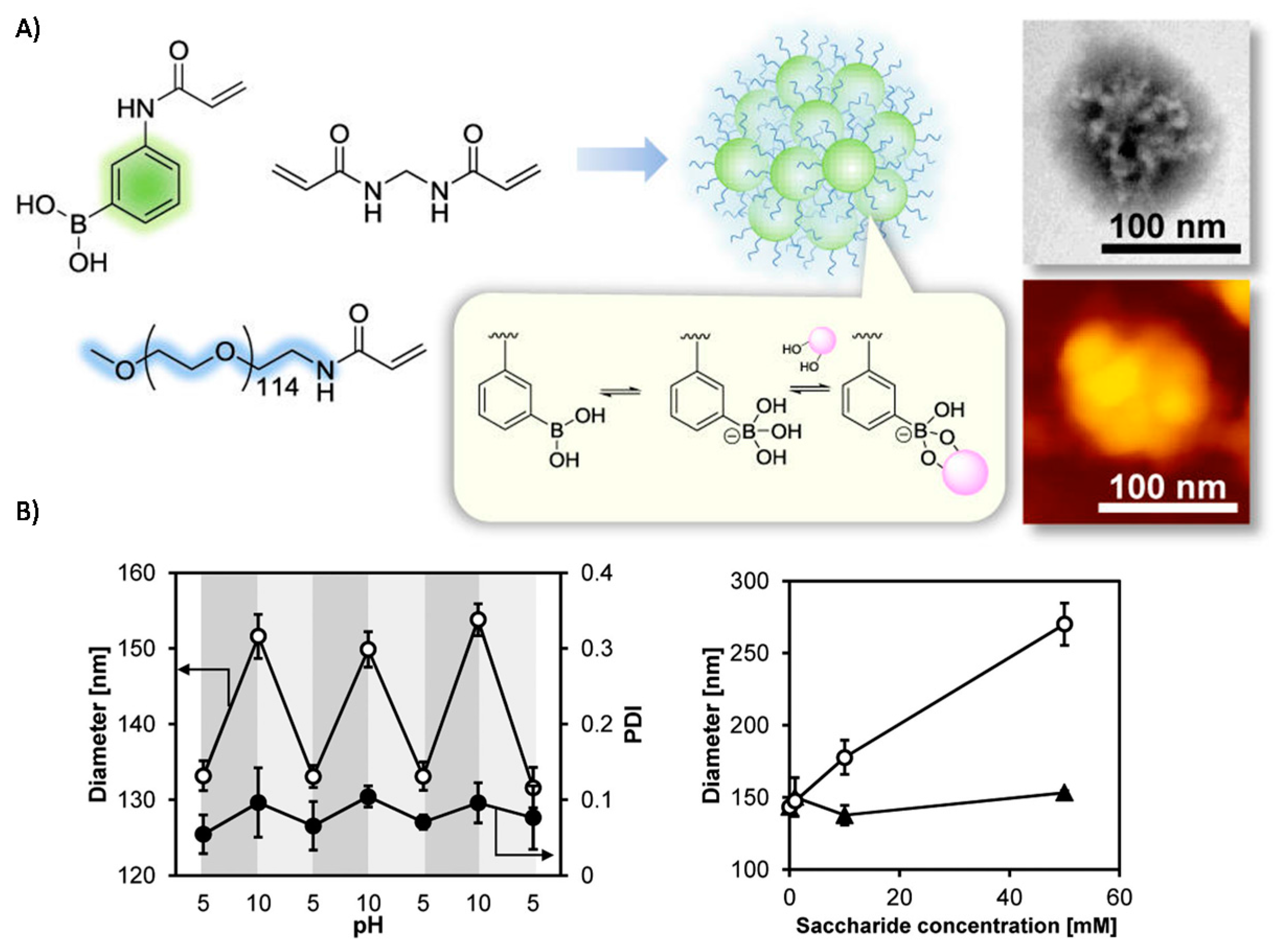
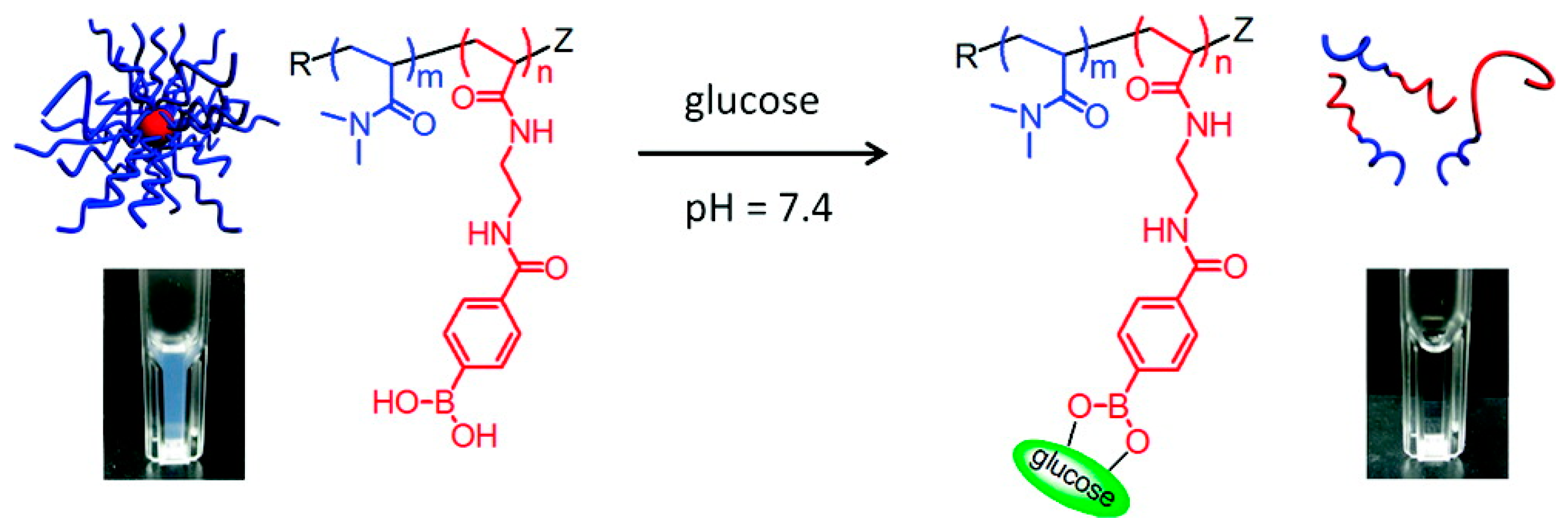
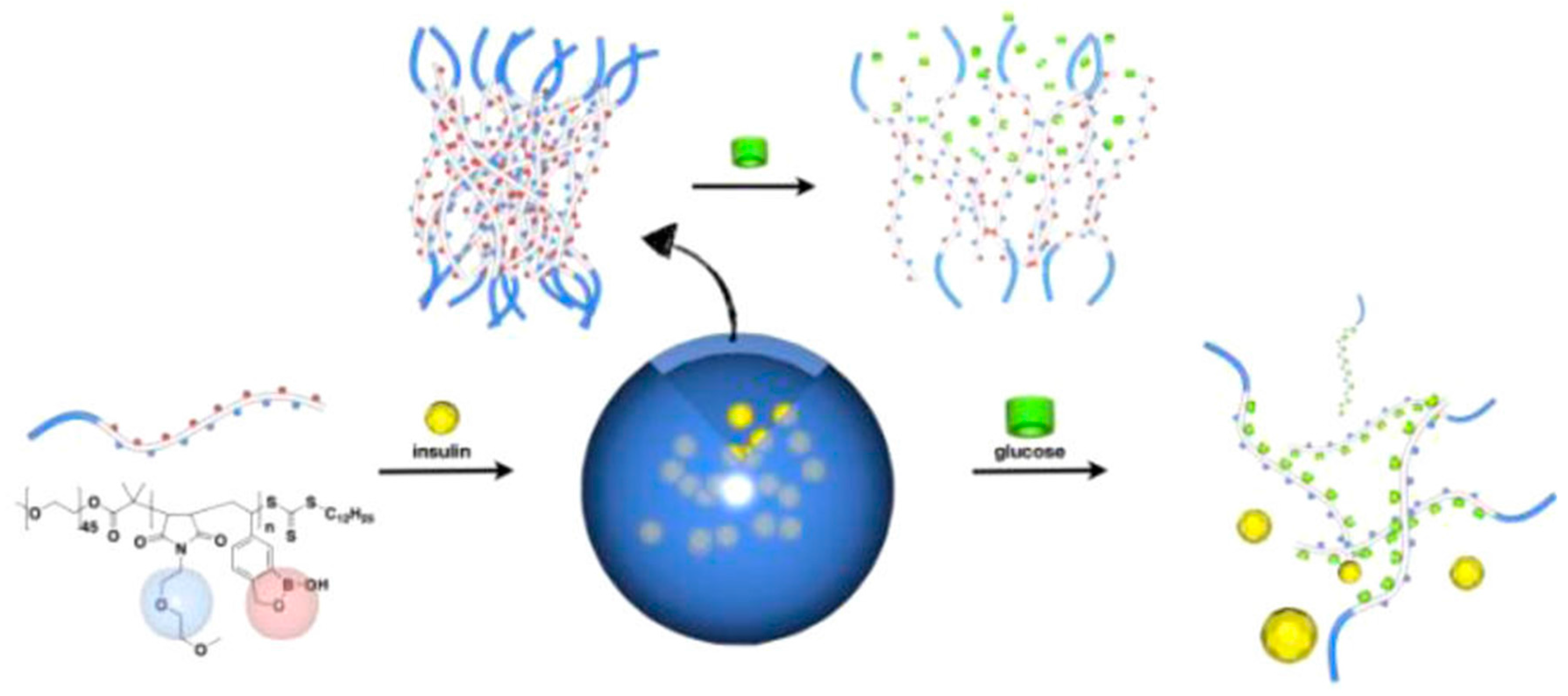
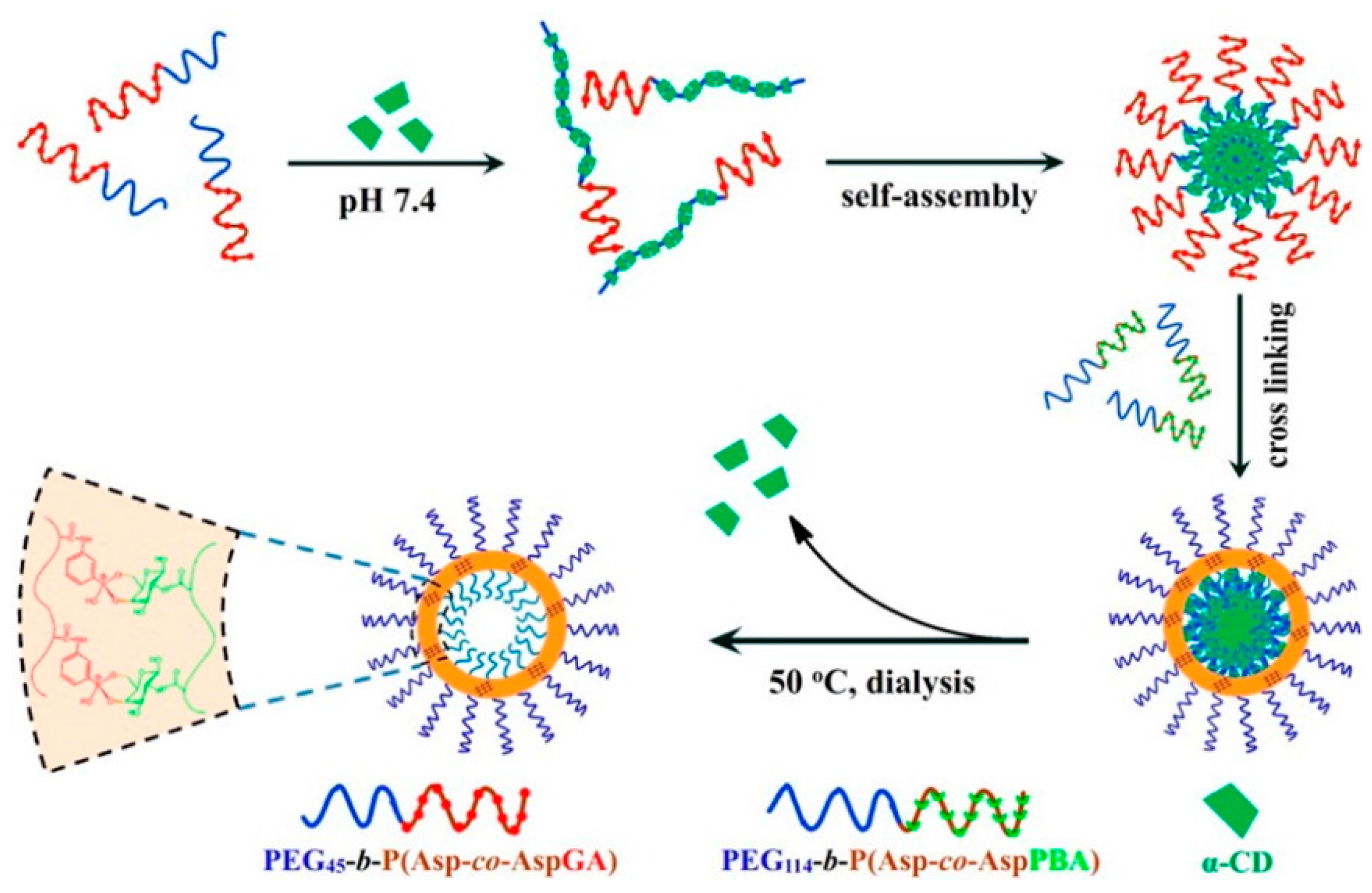
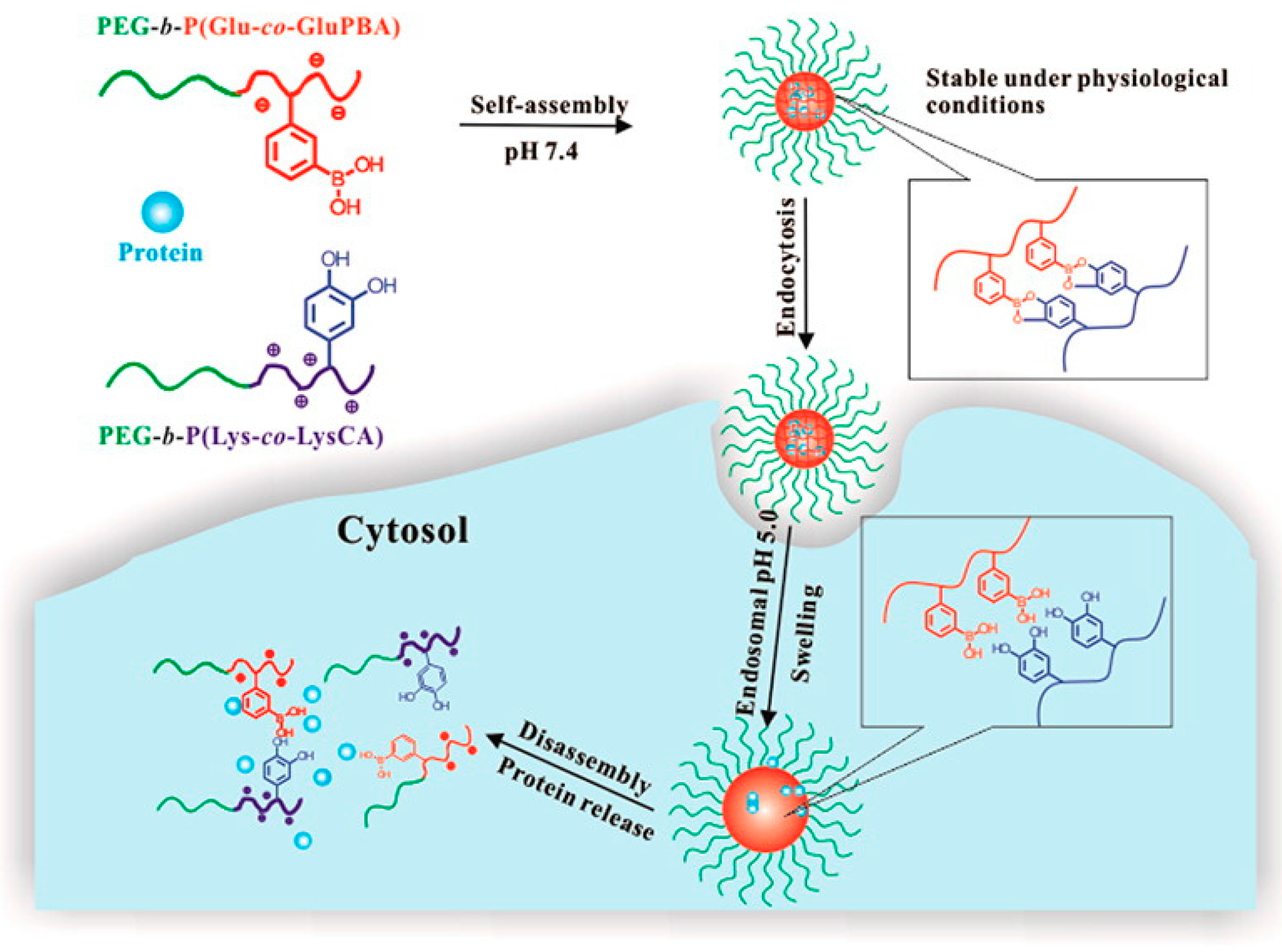

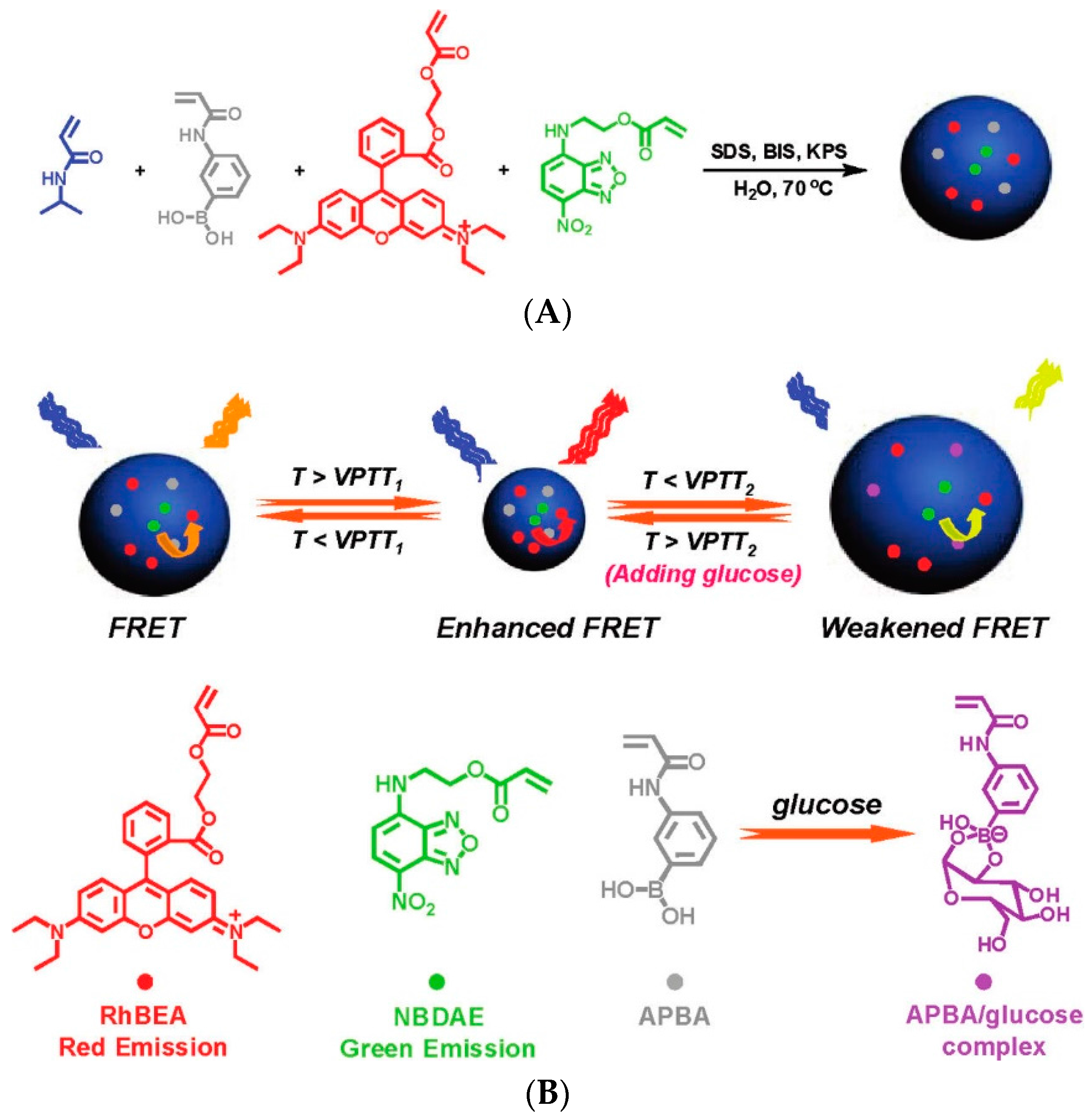
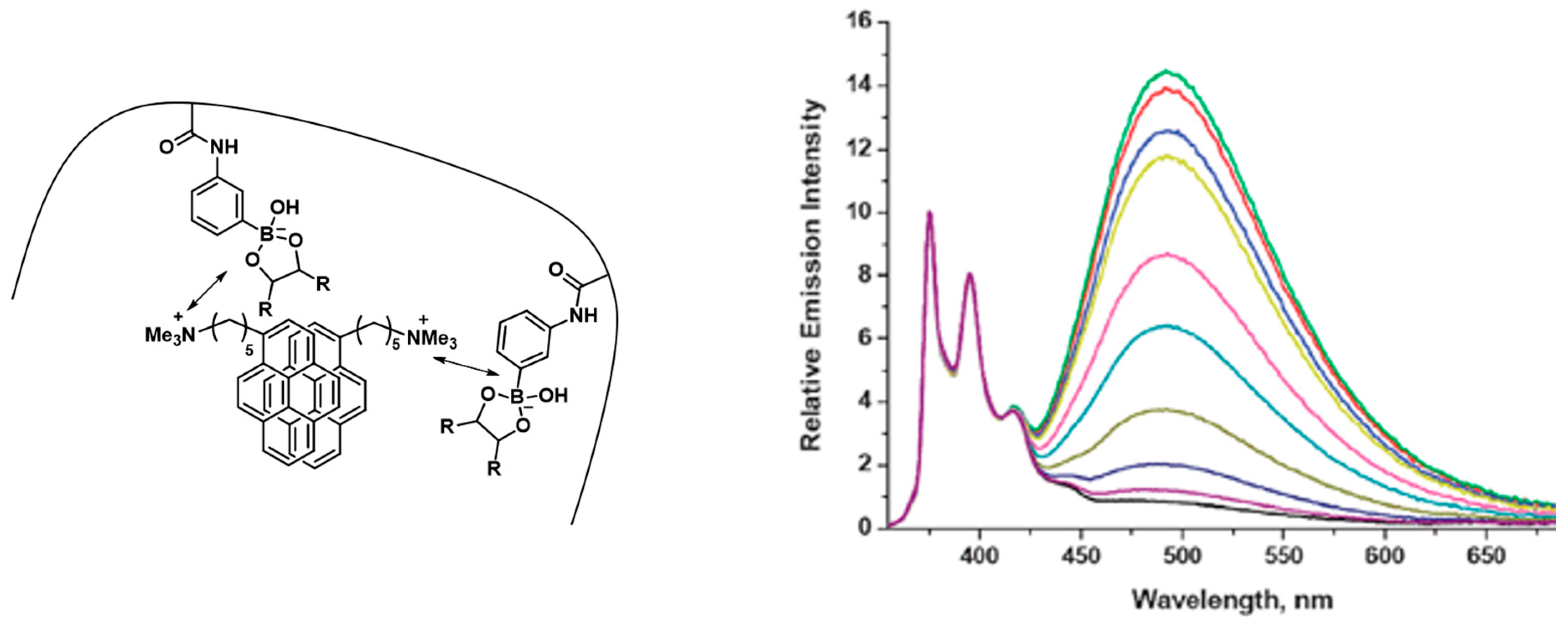
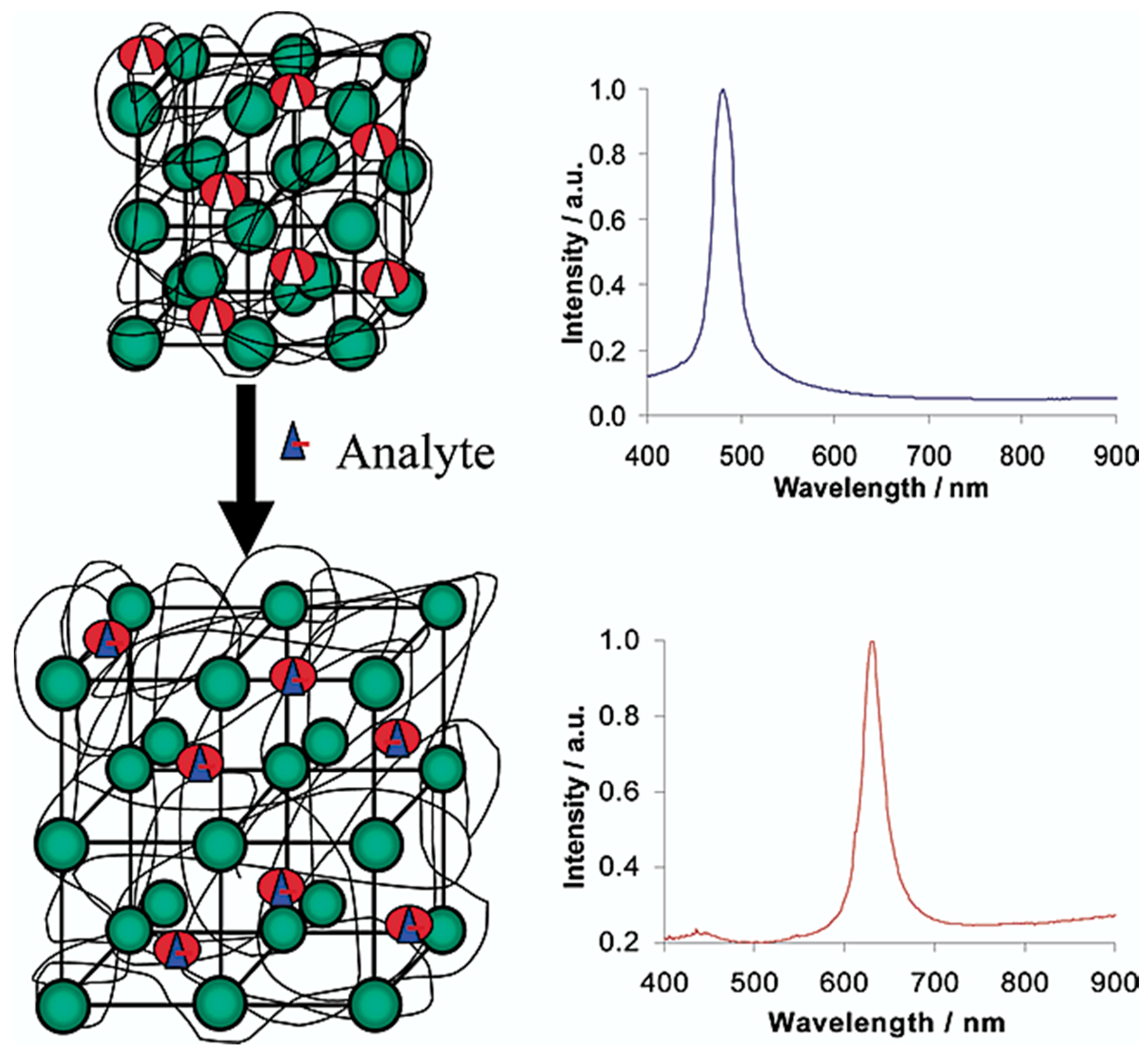
© 2016 by the authors; licensee MDPI, Basel, Switzerland. This article is an open access article distributed under the terms and conditions of the Creative Commons Attribution (CC-BY) license (http://creativecommons.org/licenses/by/4.0/).
Share and Cite
Vancoillie, G.; Hoogenboom, R. Responsive Boronic Acid-Decorated (Co)polymers: From Glucose Sensors to Autonomous Drug Delivery. Sensors 2016, 16, 1736. https://doi.org/10.3390/s16101736
Vancoillie G, Hoogenboom R. Responsive Boronic Acid-Decorated (Co)polymers: From Glucose Sensors to Autonomous Drug Delivery. Sensors. 2016; 16(10):1736. https://doi.org/10.3390/s16101736
Chicago/Turabian StyleVancoillie, Gertjan, and Richard Hoogenboom. 2016. "Responsive Boronic Acid-Decorated (Co)polymers: From Glucose Sensors to Autonomous Drug Delivery" Sensors 16, no. 10: 1736. https://doi.org/10.3390/s16101736





